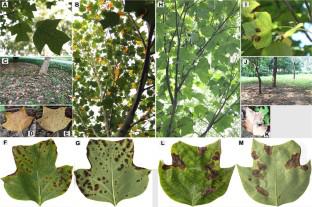European Journal of Plant Pathology ( IF 1.7 ) Pub Date : 2022-05-02 , DOI: 10.1007/s10658-022-02514-w Guiming Dou 1 , Xing Lü 1 , Ruhua Li 1 , Dong-Hui Yan 1 , Fei Ren 2

|
The hybrid tulip tree (Liriodendron chinense (Hemsl.) Sarg. × Liriodendron tulipifera L.) is one of the most valuable ornamental plants in China. Recently, two leaf anthracnose disease types have emerged on tulip trees in a park in Beijing, China. One type is yellow halo (chlorosis ring) anthracnose characterized by many small round necrotic lesions each of which is circled by a thick chlorosis ring. Lesion spots remain separate from each other even in fallen decaying leaves. Infected leaves turn entirely yellow on trees and then fall immaturely. The other type is non-yellow halo anthracnose characterized by large and irregular necrotic lesions without thick yellow belt margins. Lesions often merge into larger ones during disease development. Infected leaves do not turn yellowish or drop early. The disease pathogens were identified as Colletotrichum gloeosporioides sensu stricto strains with multi-loci phylogeny inferences and morphological differences in cultural colonies, conidia, and appressoria. The two types of Colletotrichum anthracnose diseases were recorded as novel on Liriodendron hosts based on differential characteristics in pathogenic strains, hosts, and disease symptoms. Finally, comprehensive comparisons among all reported leaf diseases on Liriodendron trees were performed according to other reported literature.











































 京公网安备 11010802027423号
京公网安备 11010802027423号